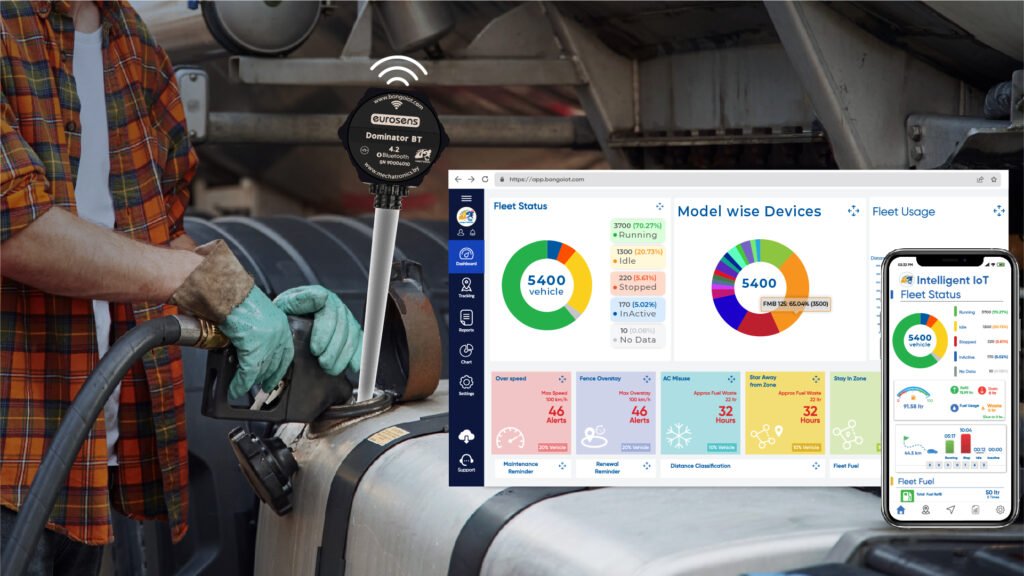
Problem
Large tanks can present challenges for fuel sensor accuracy due to their size and the dynamic nature of fuel levels. In large tanks, the volume of fuel can greatly fluctuate and cause movement within the tank, leading to irregular and unpredictable changes in fuel level. This can cause difficulties for fuel sensors in accurately measuring and transmitting the correct fuel level readings. Additionally, the size of large tanks can result in sensors being positioned far from the fuel level, reducing their effectiveness in providing accurate readings. As a result, it is important to properly calibrate and position fuel sensors in large tanks to ensure accurate readings.
Solution
Bongo Technology has implemented a dual fuel sensor solution in the Tata 407 DIM-NA 23-1695, in light of the vehicle’s larger fuel tank and the need for improved measurement accuracy. The two sensors, Mielta and Mechatronics, are capable of reducing fuel consumption and detecting fuel theft in real time. The Mechatronics sensor offers consistent data, while the deployment of two sensors provides increased accuracy and the potential to reach 99.9% accuracy. Bongo IoT has developed the Bongo Fuel Management System and the Intelligent Fleet Management System to further enhance this solution.
Vehicle Details
Vehicle Name = TATA 407 DM-NA 23-1695
Fuel Tank Capacity = 80 L
Installations
Location: Ava Enterprise, Día Bari Uttara, Dhaka
Device Implementation:
- Mielta Fuel Sensor.
- Teltonika GPS Tracker FMB125 Teltonika 5005.
- Mechatronics Fuel Sensor
Challenges:
- The size of the fuel tank was a challenge for the technician team when they attempted to drain the fuel. This is because larger tanks hold more fuel, which can make the process of draining it more difficult and time-consuming. The technicians may need to use specialized equipment or techniques to effectively drain the fuel from a large tank, which can increase the complexity and difficulty of the task. Additionally, the large volume of fuel being handled can also pose safety risks and require careful planning and execution to ensure that it is done safely and effectively
- The large size of the fuel tank made the calibration process more challenging. Calibrating a fuel tank involves measuring the volume of fuel inside and adjusting the sensors or other measuring devices to ensure accurate readings. In a large fuel tank, the volume of fuel is much greater, which can make it more difficult to measure accurately. The increased size of the tank also makes it more challenging to access the sensors or other measuring devices, as they may be located in hard-to-reach areas. Additionally, the movement of fuel within a large tank can be more dynamic, making it more difficult to obtain accurate readings. The combination of these factors can make the calibration process for large fuel tanks more time-consuming and challenging compared to smaller tanks
Results:
Following the successful installation of two fuel sensors on vehicles with large tanks, Bongo Technology believes that real-time tracking is now possible. With the installation of a GPS tracker and the implementation of an IoT Software System, companies and organizations can receive real-time monitoring of their vehicles and assign daily tasks to their drivers. This results in increased accountability and reduces the likelihood of excuses from drivers. Bongo Technology recommends this solution for those seeking real-time monitoring of their fleet, including real-time monitoring of hours worked, driver behavior, task completion, and fuel usage through alerts and reports. The solution also helps reduce false duty time claims and citizen complaints and reduces fuel wastage through idling reports and fuel level monitoring.
🌐Discover more
Visit at:
https://www.bongoiot.com/fuel-management
WhatsApp:
or,
Mail Us:
